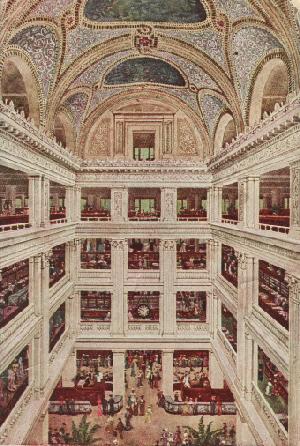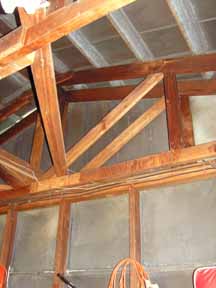|
Fieldale Historic District
Fieldale Historic District is a national historic district located at Fieldale, Henry County, Virginia. The district encompasses 329 contributing buildings and 2 contributing structures in the town of Fieldale. The majority of the buildings were built after 1916-1917 by the Marshall Field and Company as workers housing for the Fieldcrest Mills. Other notable buildings and structures include the Fieldcrest Mills Complex with the upper mill, lower mill, gatehouse, warehouse, water infiltration plant, and welder's shop; Danville & Western Station; Route 701 Bridge; Bank of Fieldale/Post Office; Fieldale Café (Fieldale Grocery; former Theater/Drug Store; Ramona's Dress Shop/Wilson's Grocery Store; Fieldale Elementary School (1924); Fieldale High School (1941); Fieldale Community Center (1937); Fieldale Hotel, and Fieldale Baptist Church. The former gas station building that houses Peggy's Antiques (044-5173-0186) was built by the Lustron Manufacturing Company. Also located in the ... [...More Info...] [...Related Items...] OR: [Wikipedia] [Google] [Baidu] |
Fieldale, Virginia
Fieldale is a census-designated place (CDP) in Henry County, Virginia, United States. The population was 879 at the 2010 census. It is part of the Martinsville Micropolitan Statistical Area. History The area was first settled in 1770 by planter George Waller, an officer in the state militia who was later promoted to Colonel, and his wife Ann Winston (Carr), first cousin of statesman Patrick Henry, as a protected ford across the Smith River. The local militia trained on Col. Waller's acreage. The settlement was subsequently known as Waller's Ford for over a century. A Virginia Historical Highway Marker unveiled in September 2017 marks the location of Col. Waller's plantation. In 1916, Marshall Field & Company purchased the site from the Waller heirs and established Fieldcrest Mills, the town of Fieldale, and an company clubhouse, all completed in 1919. The Fieldale Historic District, Marshall Field and Company Clubhouse, and Virginia Home are listed on the National Regist ... [...More Info...] [...Related Items...] OR: [Wikipedia] [Google] [Baidu] |
Historic District (United States)
Historic districts in the United States are designated historic districts recognizing a group of buildings, properties, or sites by one of several entities on different levels as historically or architecturally significant. Buildings, structures, objects and sites within a historic district are normally divided into two categories, contributing and non-contributing. Districts vary greatly in size: some have hundreds of structures, while others have just a few. The U.S. federal government designates historic districts through the United States Department of Interior under the auspices of the National Park Service. Federally designated historic districts are listed on the National Register of Historic Places, but listing usually imposes no restrictions on what property owners may do with a designated property. State-level historic districts may follow similar criteria (no restrictions) or may require adherence to certain historic rehabilitation standards. Local historic distric ... [...More Info...] [...Related Items...] OR: [Wikipedia] [Google] [Baidu] |
Henry County, Virginia
Henry County is a county located in the U.S. state of Virginia. As of the 2020 census, the population was 50,948. The county seat is usually identified as Martinsville; however, the administration building (where county offices are located and where the board of supervisors holds meetings), county courthouse, and Henry County Sheriff's Office are located on Kings Mountain Road (SR 174) in Collinsville.The Henry County Adult Detention Center is located on DuPont Road in Martinsville. Henry County is part of the Martinsville, VA Micropolitan Statistical Area. History The county was established in 1777 when it was carved from Pittsylvania County. The new county was initially named Patrick Henry County in honor of Patrick Henry, who was then serving as the first Governor of Virginia, and some of whose relatives had settled in the area. Governor Henry also had a plantation called "Leatherwood plantation" (for Leatherwood Creek) in the newly named county (where he ended up ... [...More Info...] [...Related Items...] OR: [Wikipedia] [Google] [Baidu] |
Marshall Field's
Marshall Field & Company (commonly known as Marshall Field's) was an upscale department store in Chicago, Illinois. Founded in the 19th century, it grew to become a large chain before Macy's, Inc acquired it in 2005. Its eponymous founder, Marshall Field, was a pioneering retail magnate. The company's flagship Marshall Field and Company Building on State Street in the Chicago Loop is a National Landmark. It was officially branded ''Macy's on State Street'' in 2006, when it became one of Macy's flagship stores. History Early years Marshall Field & Company traces its antecedents to a dry goods store opened at 137 Lake StreetPDX History of Marshall Field's Retrieved August 20, 2006. in , ... [...More Info...] [...Related Items...] OR: [Wikipedia] [Google] [Baidu] |
Cannon Mills
The Cannon Mills Company was an American textile manufacturing company based in Kannapolis, North Carolina, that mainly produced towels and bed sheets. Founded in 1887 by James William Cannon, by 1914 the company was the largest towel and sheets manufacturer in the world. Cannon remained family-owned until 1982 when it was sold to David H. Murdock. Murdock sold the company to Fieldcrest in 1985, becoming Fieldcrest-Cannon. The company was subsequently sold to Pillowtex Corporation in 1997, which entered bankruptcy in July 2003. The remaining Cannon brands were purchased by the Iconix Brand Group. History Early years and development In 1887 James William Cannon founded the Cannon Manufacturing Company in Kannapolis, North Carolina. His goal was to produce a basic textile product instead of yarn or another intermediate material. His company produced towels that were sold under the brand name "Cannon Towels". Ten years later, he opened another mill in Concord, North Carolina. ... [...More Info...] [...Related Items...] OR: [Wikipedia] [Google] [Baidu] |
Lustron House
Lustron houses are prefabricated enameled steel houses developed in the post-World War II era United States in response to the shortage of homes for returning G.I.s by Chicago industrialist and inventor Carl Strandlund. Considered low-maintenance and extremely durable, they were expected to attract modern families who might not have the time or interest in repairing and painting conventional wood and plaster houses. Lustron production ceased in 1950 due to the company's inability to pay back the startup loans it had received from the Reconstruction Finance Corporation. Over 2,000 homes were constructed during the Lustron's brief production period, and many remain in use today. Several have been added to the National Register of Historic Places. Development In January 1947, the newly formed Lustron Corporation announced that it had received a $12.5-million Reconstruction Finance Corporation loan to manufacture mass-produced prefabricated homes that featured vitreous enamel- coat ... [...More Info...] [...Related Items...] OR: [Wikipedia] [Google] [Baidu] |
Marshall Field And Company Clubhouse
Marshall Field and Company Clubhouse, also known as Fieldcrest Lodge, is a historic clubhouse located at Fieldale, Henry County, Virginia. It was built in 1917, and is a two-story, Tudor Revival style building. It is constructed of native Henry County fieldstone, box beams, pebble dash stucco, and red terra cotta roof tile. Also on the property are a contributing carriage house, manager's house with a matching shed structure and a three-stall barn, and a regulation size tennis court. The clubhouse was built by Marshall Field and Company to house important figures visiting the Fieldcrest Mills. an''Accompanying four photos''/ref> It was listed on the National Register of Historic Places in 2005. It is located in the Fieldale Historic District Fieldale Historic District is a national historic district located at Fieldale, Henry County, Virginia. The district encompasses 329 contributing buildings and 2 contributing structures in the town of Fieldale. The majority of the buil ... [...More Info...] [...Related Items...] OR: [Wikipedia] [Google] [Baidu] |
Virginia Home
Virginia Home is a historic boarding house located at Fieldale, Henry County, Virginia. It was built in 1920, and is a two-story, seven-bay, frame structure with a hipped roof and a full, two-story porch. Also on the property are a contributing cook's house, a wash house, and a one-story cottage for the staff of the Virginia Home. The Virginia Home was built by Marshall Field and Company as a boarding house for workers at the Fieldcrest Mills. an''Accompanying photo''/ref> It was listed on the National Register of Historic Places in 2000. It is located in the Fieldale Historic District Fieldale Historic District is a national historic district located at Fieldale, Henry County, Virginia. The district encompasses 329 contributing buildings and 2 contributing structures in the town of Fieldale. The majority of the buildings were .... References Houses on the National Register of Historic Places in Virginia Houses completed in 1920 Houses in Henry County, Virginia Na ... [...More Info...] [...Related Items...] OR: [Wikipedia] [Google] [Baidu] |
National Register Of Historic Places
The National Register of Historic Places (NRHP) is the United States federal government's official list of districts, sites, buildings, structures and objects deemed worthy of preservation for their historical significance or "great artistic value". A property listed in the National Register, or located within a National Register Historic District, may qualify for tax incentives derived from the total value of expenses incurred in preserving the property. The passage of the National Historic Preservation Act (NHPA) in 1966 established the National Register and the process for adding properties to it. Of the more than one and a half million properties on the National Register, 95,000 are listed individually. The remainder are contributing resources within historic districts. For most of its history, the National Register has been administered by the National Park Service (NPS), an agency within the U.S. Department of the Interior. Its goals are to help property owners a ... [...More Info...] [...Related Items...] OR: [Wikipedia] [Google] [Baidu] |
Historic Districts On The National Register Of Historic Places In Virginia
History (derived ) is the systematic study and the documentation of the human activity. The time period of event before the invention of writing systems is considered prehistory. "History" is an umbrella term comprising past events as well as the memory, discovery, collection, organization, presentation, and interpretation of these events. Historians seek knowledge of the past using historical sources such as written documents, oral accounts, art and material artifacts, and ecological markers. History is not complete and still has debatable mysteries. History is also an academic discipline which uses narrative to describe, examine, question, and analyze past events, and investigate their patterns of cause and effect. Historians often debate which narrative best explains an event, as well as the significance of different causes and effects. Historians also debate the nature of history as an end in itself, as well as its usefulness to give perspective on the problems of the p ... [...More Info...] [...Related Items...] OR: [Wikipedia] [Google] [Baidu] |
Buildings And Structures In Henry County, Virginia
A building, or edifice, is an enclosed structure with a roof and walls standing more or less permanently in one place, such as a house or factory (although there's also portable buildings). Buildings come in a variety of sizes, shapes, and functions, and have been adapted throughout history for a wide number of factors, from building materials available, to weather conditions, land prices, ground conditions, specific uses, prestige, and aesthetic reasons. To better understand the term ''building'' compare the list of nonbuilding structures. Buildings serve several societal needs – primarily as shelter from weather, security, living space, privacy, to store belongings, and to comfortably live and work. A building as a shelter represents a physical division of the human habitat (a place of comfort and safety) and the ''outside'' (a place that at times may be harsh and harmful). Ever since the first cave paintings, buildings have also become objects or canvasses of much artistic ... [...More Info...] [...Related Items...] OR: [Wikipedia] [Google] [Baidu] |


_(1909)_(14588608988).jpg)


.jpg)
